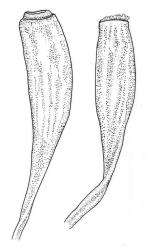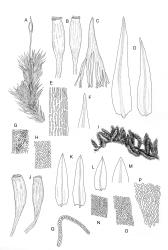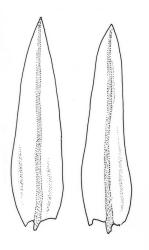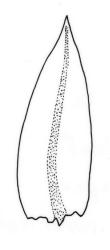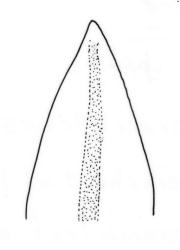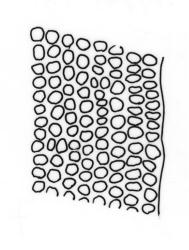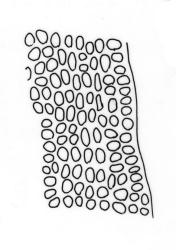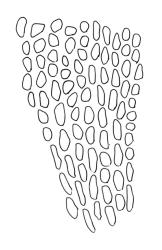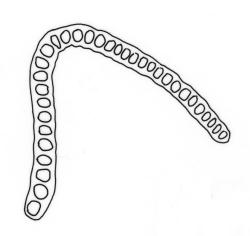- ≡ Macromitrium ramsayae Vitt, J. Hattori Bot. Lab. 54: 14 (1983)
Branches mostly short, 3–8 mm. Branch leaves erect-spreading and nearly straight when moist, loosely to tightly spiralled around the branch and with the upper portions flexuose and recurved when dry, narrowly oblong to broadly lanceolate-oblong, mostly acute or shortly cuspidate, deeply keeled below, becoming flattened near apices, 1.6–2.5 mm; upper laminal cells rounded-quadrate to rounded-rectangular, a few sometimes oblate, unistratose except at extreme apex (uppermost c. 200 to c. 750 μm of leaf) and there usually bistratose; inner basal cells rounded-subquadrate to elliptic (often with a few oblate or shortly rectangular), very weakly bulging, mostly evenly thick-walled, 9–15(–21) × c. 9–11 μm. Costa mostly ending a few cells below apex, the abaxial superficial cells elongate except at extreme tip, the adaxial superficial cells not observed (due to deeply keeled leaves). Perichaetial leaves smaller than branch leaves, c. 1.3–1.8 mm, ovate, acute. Setae 2.5–4 mm; capsules 1.2–2.3 mm. Spores isosporous, 20–28 μm.
Vitt 1983, figs 17–24, 26–29 (as M. ramsayae).
Ch (Te Whanga Lagoon, Waterfall Creek, Rangaika Scenic Reserve, Pitt I., Rangatira I.).
Endemic.
On basalt and tree trunks in areas exposed to salt spray. Host species include Corynocarpus laevigatus, Cyathodes sp., Myrsine chathamica, and Cupressus macrocarpa. Ranging from near sea level to at least 250 m elevation. While frequently forming extensive and nearly pure mats, this taxon is often associated with Lembophyllum divulsum and Zygodon hookeri.
Vitt (1983, p. 18) differentiated M. ramsayae from M. longirostre by its dull, olive-green coloration; oblong leaves sharply narrowed to acute or bluntly cuspidate, flattened apices (never as slenderly acuminate as in M. longirostre, except in the lowest branch leaves); unistratose, thin-walled and obscure upper laminal cells; and the short, mostly rounded, basal leaf cells. He seemed to have been concerned by variation and intergradation in the shape of the basal laminal cells, the differentiating feature he most emphasised in his key to species (p. 8).
In CHR there are c. 12 collections of "M. ramsayae" made since 1983. Although extreme forms of M. longirostre s.l. indeed give the impression of being distinct, when the full range of Chatham Is material is examined no morphological discontinuity can be demonstrated, indicating that reduction to varietal rank is warranted.



